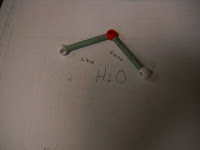




Purpose: to determine the number of grams of copper that will be produced from an oxidation reduction reaction when you know the mass of Aluminum that react with a known amount of copper II sulfate pentahydrate and to compare this to the actual yield of copper.
Background Information:
Copper precipitate is a by product of the reaction between aluminum and copper sulfate.
Oxidation is the loss of electrons or an increase in oxidation state by a molecule,ion, or atom. Reduction is the gain of electrons or a decrease in oxidation state by a molecule, ion, or atom.
Actual yield: It is given as the weight in grams or in moles.Theoretical Yield:The quantity of a product obtained from the complete conversion of the limiting reactant in a chemical reaction. Theoretical yield is commonly expressed in the terms of grams or moles. Percentage yield: Calculate to be the experimental yield divided by theoretical yield multiplied by a hundred percent.

Materials:
- Aluminum
- Copper sulfate pentahydrate
- Beaker
- Stirring rod
- Filter
Safety Per cations:
- Safety goggles
- Apron
- Clamps
Procedure:
- Obtain a medium sized beaker
- Add 75-100 mL of water to beaker; set-up apparatus to heat your mixture over a Bunsen burner to begin heating.
- Measure out about 15 g of Copper(II) Sulfate Pentahydrate (CuSO4 . 5H2O) and record the mass in the data table. Then slowly add the crystals to the heating water.
- With a glass stirring-rod, stir the solution until the Copper(II) Sulfate Pentahydrate is dissolved.
- While the copper sulfate crystals are dissolving one member of the group can go and get the foil. Carefully weigh out a piece of aluminum foil that weighs between 0.7 and 1.0 grams. Record the mass exactly into the data table (hundredths place).
- Tear the foil into small pieces and carefully add it to the hot solution with continuous stirring until all the foil is placed into the beaker.
- Stirring frequently, allow the reaction to occur until you can't see any more sliver foil pieces. This will take 15 to 20 minutes, so be patient. Once you can't see anymore foil pieces, no matter how small, heat an additional 3 to 4 minutes. Then remove from heat.
- Write your names around the outside edge of a filter paper (so you can claim it later), weigh and record the mass in the data table.
- Use the filter paper and your funnel to filter the residue in the beaker, catching the filtrate into the Erlenmeyer flask provided.
- Rinse out your beaker with a small (amount just covering the bottom of the beaker) of water to be sure you obtained all the product/residue
- Remove the filter paper from the funnel and spread it out on a paper towel to dry overnight.
- Clean and dry the glassware. Be sure the propane is turned off and Bunsen burner disconnected and put away. Straighten up your area.
- Upon returning the next day, weigh the filter paper and dry the residue and record the mass in the data table, Throw the paper and residue away.

1. 3Cu(SO4) + 2Al --> 3Cu + Al2(SO4)3
2. .62g Al x 1molAl/26.98g x 3 mol Cu/ 2 mol Al x 63.546 g Cu/ 1 mol Cu= 2.19g Cu (theoretical yield)
3. The actual yield measured was 1.53g Cu.
4. 1.53/2.19= .6986= 69.86% Yield
5. Reasons why we only got ~ 70% of the Copper that had been predicted.
We might not of spent enough time during the expirement to allow all of the Aluminum to react with the Copper Sulfate-Pentahydrate.
Our expirement techniques heating, precipitate gathering, etc. might of caused some the the copper to not get caught by the filter.
Byproducts may have been created that could have subtracted some of the Cu from our precipitate that could have not been measured and disposed of with the waste.
Conclusion: In the duration of the lab we determined the number of grams of Cu that was produced from oxidation reduction reaction and compared the mass of Al that reacted with the Cu II Sulfate pentahydrate to the actual yield of Cu. This lab was extremely helpful in the learning process on how balance equations, how figuring out the reaction before hand in your balanced equation is a great idea to discuss and make a hypothesis. Thank you for reading our blog, hopefully you will get out there and try it on your own and then follow up with a blog of your own and a comparison!




















